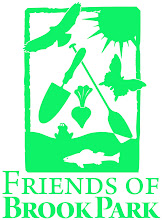Friday, May 15, 2009
Monday, May 04, 2009
Robin's Nest in Brook Park


To hear 3 Robin Songs CLICK HERE
Robin Nesting Habits
The song of the male is to advertise his territory or to attract a mate. You'll hear them the most just before the young hatch.
The nest is made of grasses, a middle layer of mud, then lined with fine grasses. The nest is usually placed in the crotch of a tree or shrub 5-20 feet above ground.
The availability of mud at nesting time may entice these birds to nest nearby. They will also make use of wool, string and hair, even plastic twine as you see in this picture.
American Robins can produce three successful broods in one year. On average, though, only 40 percent of nests successfully produce young.
Only 25 percent of those fledged young survive to November. From that point on, about half of the birds alive in any year will make it to the next.
Despite the fact that they can live to be 14 years old, the entire population turns over on average every six years. The female lays 3-7 light blue eggs that are incubated for 12-14 days and the young leave the nest in about 14-16 days.
2 - 3 broods raised each season.
Feeding Habits
Robins eat different types of food depending on the time of
baby robins being fed
day. They eat earthworms early in the day and more fruit later in the day.
Because they forage largely on lawns, they are vulnerable to pesticide poisoning and can be an important indicator of chemical pollution. Artificial turf fields limit bird habitat significantly
American Robin Habitat
This is a bird of woodland edges and opening. Prefering open ground on which it can forage for insects. Try placing fruit on tray feeders or planting fruiting shrubs to attract more of them to your backyard garden.
After the breeding season, Robins flock together and go to large communal roosts at night. This habit continues from fall through winter.
Sunday, May 03, 2009
Newton Pippin Apple Tree & Earth Week
We had a great week in the garden with over 100 student participants on different days.
We planted four fruit trees, among many other fun and educational activities.
Thanks to Erik Baard and Green Apple Cleaners, we also received a Newton Pippin apple tree to plant. Never heard of it? Read the NY Times article below...
Should the Big Apple’s Official Apple Be Green?
By Jennifer 8. Lee
Newtown Pippin apples.Thomas Jefferson Foundation Some believe that the green, lopsided Newtown Pippin apple, which originated in Queens and went on to be popular during the Colonial period, should be the official apple of New York City.
The apple of the Big Apple is almost nearly always portrayed as red (despite City Hall’s recent environmental aspirations).
But what if it were actually green?
A coalition of local environmental groups are pushing for a lopsided, mottled green apple to be the “official apple of New York.”... see more at: NYTIMES ARTICLE HERE


